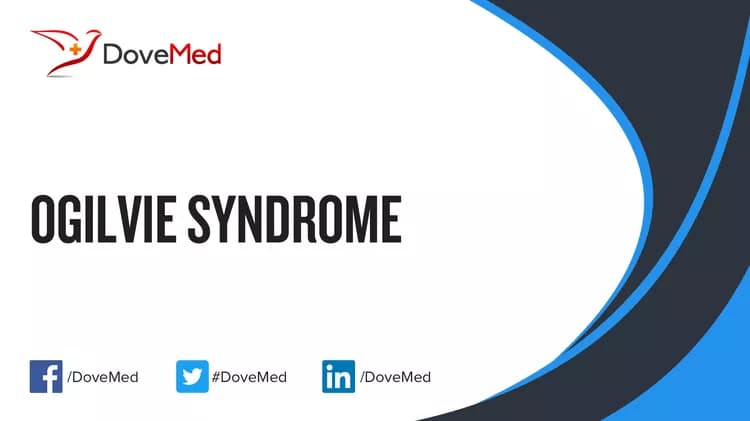What are the other Names for this Condition? (Also known as/Synonyms)
- Acute Colonic Ileus
- Acute Colonic Pseudo-Obstruction
- Ogilvie's Syndrome
What is Ogilvie Syndrome? (Definition/Background Information)
- Ogilvie Syndrome is a rare condition that affects the large intestines (colon)
- Although the signs and symptoms mimic those of an intestinal blockage, there is no physical obstruction. Instead, the symptoms are due to nerve or muscle problems that affect peristalsis (the involuntary, rhythmic muscular contractions that move food, fluid, and air through the intestines)
- In people affected by Ogilvie Syndrome, the symptoms come on suddenly and may include abdominal pain, nausea, vomiting, abdominal distention (swelling), constipation, and/or diarrhea
- If untreated, the condition can cause malnutrition, bacterial overgrowth in the intestines, and weight loss
- The underlying cause of Ogilvie Syndrome is poorly understood. However, it usually occurs in adults when the colon becomes enlarged after surgery, illness or injury
- Treatment options for Ogilvie Syndrome include supportive therapy that addresses associated symptoms, medications, decompression (a procedure that reduces pressure within the colon) and surgery
(Source: Ogilvie Syndrome; Genetic and Rare Disease Information Center (GARD) of National Center for Advancing Translational Science (NCATS), USA.)
Who gets Ogilvie Syndrome? (Age and Sex Distribution)
- Ogilvie Syndrome is a rare acquired disorder; it occurs following an acute illness or injury
- The presentation of symptoms may occur at any age, but most often occurs in individuals in late middle age. The average age at diagnosis is 60 years
- Both males and females may be affected by this condition
- Worldwide, individuals of all racial and ethnic groups may be affected
What are the Risk Factors for Ogilvie Syndrome? (Predisposing Factors)
The risk factors for Ogilvie Syndrome may include:
- Late middle age
- An acute illness or injury in a hospital or institutional setting
It is important to note that having a risk factor does not mean that one will get the condition. A risk factor increases one’s chances of getting a condition compared to an individual without the risk factors. Some risk factors are more important than others.
Also, not having a risk factor does not mean that an individual will not get the condition. It is always important to discuss the effect of risk factors with your healthcare provider.
What are the Causes of Ogilvie Syndrome? (Etiology)
The exact cause of Ogilvie Syndrome is not known at the present time, but the condition is associated with an acute illness or injury in an institutionalized setting.
What are the Signs and Symptoms of Ogilvie Syndrome?
The signs and symptoms of Ogilvie Syndrome may come on suddenly and include:
- Abdominal pain
- Nausea
- Vomiting
- Abdominal distention (swelling)
- Constipation
- Diarrhea
(Source: Ogilvie Syndrome; Genetic and Rare Disease Information Center (GARD) of National Center for Advancing Translational Science (NCATS), USA.)
How is Ogilvie Syndrome Diagnosed?
Ogilvie Syndrome is diagnosed on the basis of the following information:
- Complete physical examination
- Thorough medical history evaluation
- Assessment of signs and symptoms
- Laboratory tests
- Imaging studies
- Biopsy studies, if necessary
Many clinical conditions may have similar signs and symptoms. Your healthcare provider may perform additional tests to rule out other clinical conditions to arrive at a definitive diagnosis.
What are the possible Complications of Ogilvie Syndrome?
The complications of Ogilvie Syndrome may include:
- Malnutrition
- Significant weight loss
- Bacterial overgrowth in the intestines
- Bowel perforation
Complications may occur with or without treatment, and in some cases, due to treatment also.
How is Ogilvie Syndrome Treated?
The treatment for Ogilvie Syndrome may include the following:
- Stopping oral intake of foods and fluids, and substitution of nutrients and electrolytes via intravenous fluids
- Administration of antibiotics, if there is bacterial infection
- The medication neostigmine to improve bowel mobility
- Colonic decompression procedure
- A cecostomy procedure (performed in cases where there is no perforation of the bowel) to create an artificial opening in the cecum, allowing the venting of excess air or other contents form the colon
- Surgical repair of perforated bowel
How can Ogilvie Syndrome be Prevented?
Since the exact cause of Ogilvie Syndrome is not known, there are no methods or guidelines available for its prevention
- Close monitoring of hospitalized or institutionalized older adults after an acute illness or surgery, may help diagnose the condition early, and prevent complications
- Active research is currently being performed to explore the possibilities for treatment and prevention of disorders such as Ogilvie Syndrome
Regular medical screening at periodic intervals with tests and physical examinations are recommended.
What is the Prognosis of Ogilvie Syndrome? (Outcomes/Resolutions)
- The prognosis of Ogilvie Syndrome is dependent upon the severity of the signs and symptoms and associated complications, if any
- Individuals with mild conditions have better prognosis than those with severe symptoms and complications
- Typically, the prognosis may be assessed on a case-by-case basis
Additional and Relevant Useful Information for Ogilvie Syndrome:
The following DoveMed website link is a useful resource for additional information:
Related Articles
Test Your Knowledge
Asked by users
Related Centers
Related Specialties
Related Physicians
Related Procedures
Related Resources
Join DoveHubs
and connect with fellow professionals


0 Comments
Please log in to post a comment.